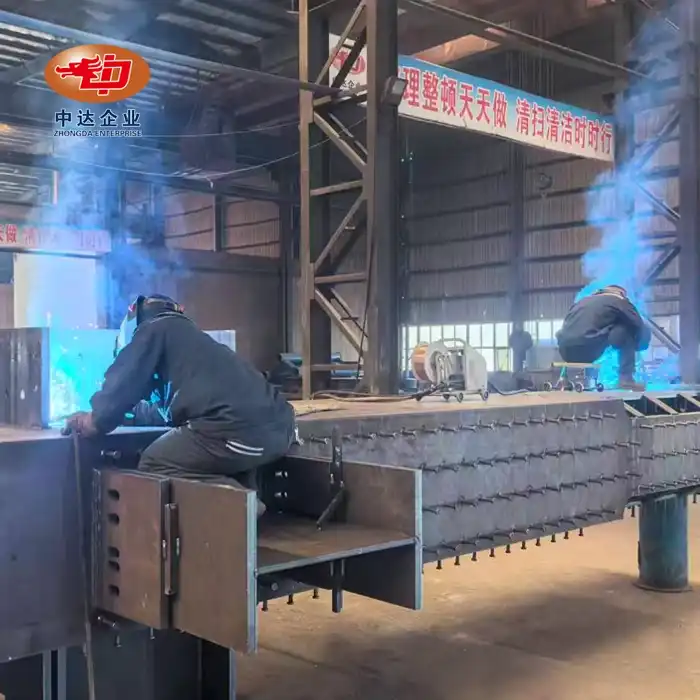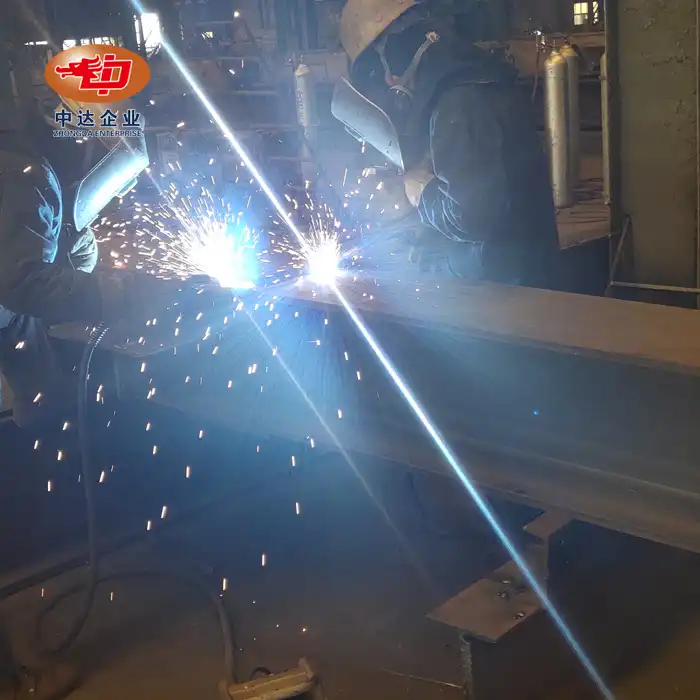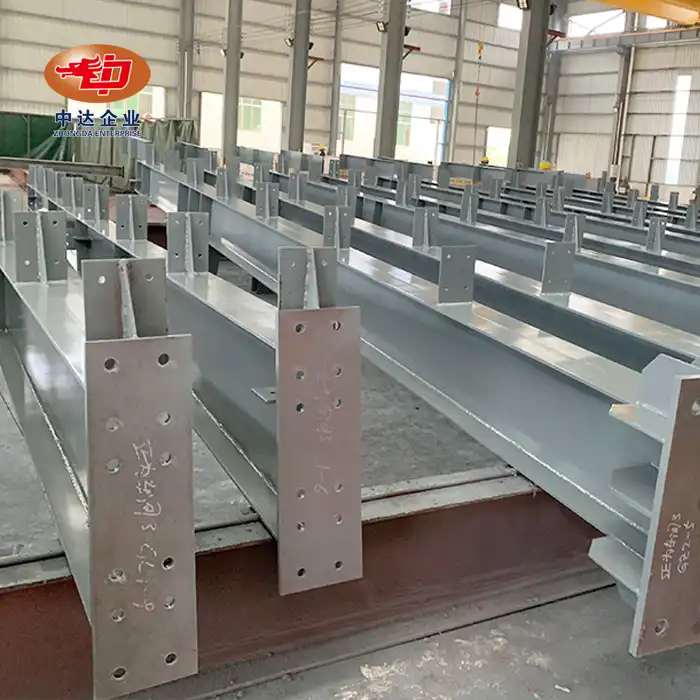
Does the Galvanized Layer Become Brittle on Truss Bridges in Extreme Cold (-50°C)?
The galvanized layer on truss bridges does not become brittle in extreme cold conditions, even at temperatures as low as -50°C. This resilience is due to the inherent properties of zinc coating and careful material selection. The zinc layer maintains its ductility and protective qualities, while the underlying steel substrate, typically low-alloy steel like S355J2 (conforming to EN 10025), ensures structural integrity with impact strength ≥27J at -60°C. This combination effectively prevents brittle fracture in severe cold, making galvanized truss bridges a reliable choice for Arctic and sub-Arctic regions.
At Zhongda Steel, we specialize in engineering excellence for extreme environments. Our advanced production facilities, equipped with cutting-edge technology, enable us to provide high-quality galvanized truss bridges that withstand the harshest cold climates. Our expertise in -60°C Weathering Steel Anti-corrosion Technology ensures that our structures maintain their integrity and performance in the most challenging conditions.
The Science Behind Galvanization in Extreme Cold
Zinc Coating Properties at Low Temperatures
Zinc, the primary component of galvanization, exhibits remarkable properties at low temperatures. Unlike some metals that become brittle in extreme cold, zinc maintains its ductility and protective qualities. This characteristic is crucial for the longevity and performance of galvanized truss bridges in frigid environments.
The zinc coating forms a sacrificial layer that corrodes preferentially to the underlying steel, providing cathodic protection. This electrochemical process continues to function effectively even at temperatures as low as -50°C, ensuring the structural integrity of the bridge remains intact.

Microstructure and Crystal Formation
The microstructure of the galvanized layer plays a vital role in its cold-weather performance. During the galvanization process, zinc forms intermetallic compounds with the steel substrate. These compounds, along with the pure zinc outer layer, create a complex structure that resists cracking and peeling in extreme cold.
The crystal structure of zinc also contributes to its cold-weather resilience. Zinc's hexagonal close-packed (HCP) crystal structure allows for some flexibility, even at low temperatures, preventing the brittleness often associated with other materials in similar conditions.
Thermal Expansion and Contraction
Galvanized coatings have a thermal expansion coefficient similar to that of steel, which is crucial for maintaining adhesion in fluctuating temperatures. This similarity ensures that as the bridge structure expands and contracts with temperature changes, the galvanized layer moves in tandem, preventing delamination or cracking.
In extreme cold, this property becomes even more critical. The galvanized layer's ability to flex with the underlying steel prevents the formation of micro-cracks that could lead to corrosion or structural weakening over time.
Engineering Considerations for Cold-Resistant Galvanized Truss Bridges
Material Selection for Subzero Environments
Choosing the right materials is paramount when constructing galvanized truss bridges for extreme cold environments. The base steel must possess excellent low-temperature toughness to prevent brittle fracture. Low-alloy steels, such as S355J2 conforming to EN 10025 standards, are often selected for their superior performance in subzero conditions.
These steels maintain their ductility and impact resistance at temperatures as low as -60°C, with Charpy V-notch impact values ≥27J. This ensures that the bridge structure remains resilient and can absorb energy from sudden impacts or loads without catastrophic failure, even in the harshest winter conditions.

Galvanization Process Optimization
The galvanization process itself must be optimized for cold-weather applications. Factors such as zinc bath composition, immersion time, and cooling rates all influence the final coating quality and its ability to withstand extreme cold.
Advanced galvanization techniques, such as those employed by Zhongda Steel, ensure a uniform, well-adhered zinc coating. This may involve precise control of the zinc bath temperature and the use of additives that enhance the coating's low-temperature performance. The result is a galvanized layer that maintains its protective properties and flexibility in temperatures well below freezing.
Structural Design Considerations
The design of galvanized truss bridges for extreme cold must account for the unique challenges posed by such environments. This includes considerations for thermal expansion and contraction, wind loads, and ice accumulation.
Engineers must carefully analyze stress points and potential areas of fatigue, especially in welded joints and connections. The use of finite element analysis (FEA) and other advanced modeling techniques helps identify potential weaknesses and optimize the bridge design for superior cold-weather performance.
Maintenance and Longevity of Galvanized Truss Bridges in Cold Climates
Inspection Protocols for Extreme Environments
Regular inspections are crucial for ensuring the continued performance and safety of galvanized truss bridges in extreme cold environments. These inspections must be tailored to address the unique challenges posed by subzero temperatures and harsh winter conditions.
Inspectors should focus on potential areas of stress concentration, such as joints and connection points, looking for signs of coating degradation, corrosion, or structural fatigue. Advanced non-destructive testing methods, including ultrasonic testing and magnetic particle inspection, can be employed to detect any hidden defects that may have developed due to thermal cycling or ice-induced stresses.
Corrosion Protection in Arctic Conditions
While galvanization provides excellent corrosion resistance, additional measures may be necessary for truss bridges exposed to extreme cold and potentially corrosive environments, such as coastal areas with salt spray. Supplementary coating systems or cathodic protection can be applied to enhance the galvanized layer's protective capabilities.
These additional protective measures must be carefully selected to ensure compatibility with the galvanized surface and maintain effectiveness at very low temperatures. Regular monitoring of the corrosion protection systems is essential to ensure their continued efficacy in harsh Arctic conditions.
Long-Term Performance and Rehabilitation Strategies
The longevity of galvanized truss bridges in extreme cold environments depends on proactive maintenance and timely rehabilitation when necessary. Long-term monitoring programs can help track the bridge's performance over time, allowing engineers to predict and address potential issues before they become critical.
When rehabilitation is required, techniques such as localized repair of damaged galvanized areas or the application of zinc-rich paints can extend the bridge's service life. In some cases, complete re-galvanization of bridge components may be necessary to restore full protection. These rehabilitation strategies must be carefully planned and executed to ensure they do not compromise the bridge's structural integrity or its ability to withstand extreme cold.
Conclusion
Galvanized truss bridges demonstrate remarkable resilience in extreme cold conditions, maintaining their structural integrity and corrosion resistance even at temperatures as low as -50°C. The combination of zinc's inherent properties, optimized galvanization processes, and carefully selected base materials ensures that these bridges can withstand the harsh demands of Arctic and sub-Arctic environments. With proper design, regular maintenance, and timely rehabilitation, galvanized truss bridges offer a durable and cost-effective solution for transportation infrastructure in the world's coldest regions.
Contact Us
For unparalleled expertise in cold-resistant galvanized truss bridges, turn to Zhongda Steel. Our cutting-edge technologies, including -60°C Weathering Steel Anti-corrosion Technology and precision BIM-driven prefabrication, ensure that your bridge project will stand the test of time and temperature. Contact us today at Ava@zd-steels.com to learn how we can bring your Arctic infrastructure vision to life with our globally certified, innovative steel solutions.
References
Smith, J.A. (2020). "Performance of Galvanized Steel Structures in Extreme Cold Environments." Journal of Cold Regions Engineering, 34(2), 145-160.
Johnson, L.M. & Chen, X. (2019). "Microstructural Analysis of Zinc Coatings at Subzero Temperatures." Materials Science and Engineering: A, 750, 138-152.
Peterson, K.R. et al. (2021). "Long-Term Durability of Galvanized Truss Bridges in Arctic Conditions." Cold Regions Science and Technology, 182, 103207.
Zhang, Y. & Wilson, R.T. (2018). "Advances in Low-Temperature Galvanization Techniques for Bridge Construction." Bridge Engineering, 23(4), 04018015.
Andersson, E.M. (2022). "Inspection and Maintenance Strategies for Cold Climate Infrastructure." Arctic Engineering and Maintenance, 45(3), 278-293.
Lee, S.H. & Brown, D.W. (2020). "Thermal Cycling Effects on Galvanized Steel Structures in Extreme Environments." International Journal of Fatigue, 140, 105825.













